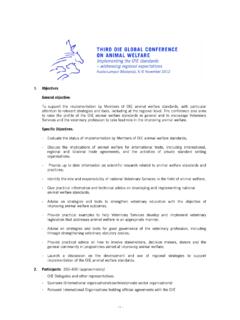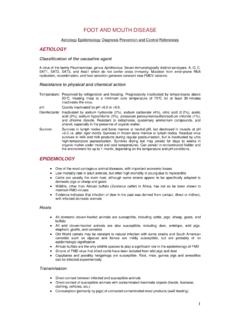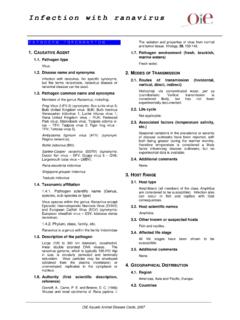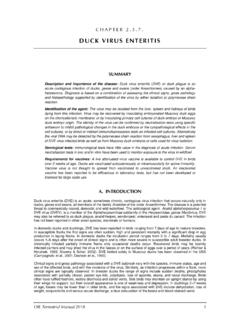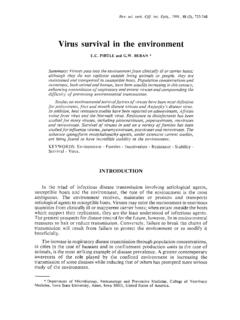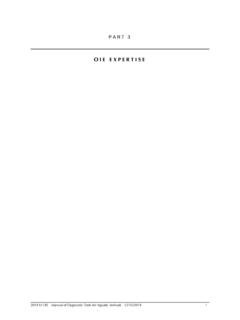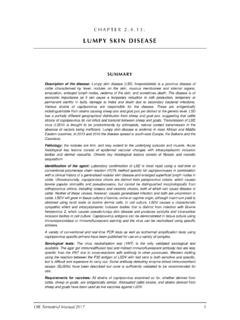Transcription of METHODS FOR DISINFECTION OF AQUACULTURE …
1 Manual of Diagnostic Tests for Aquatic Animals 2009 31 CHAPTER METHODS FOR DISINFECTION OF AQUACULTURE ESTABLISHMENTS 1. General principles DISINFECTION is employed as a common disease management tool in AQUACULTURE establishments. It may be used as a routine practice in biosecurity programmes designed to exclude specific diseases, as well as a routine sanitary measure employed to reduce disease incidence within farms, or it may be used in disease eradication (stamping out) efforts. The specific reason for DISINFECTION will determine the DISINFECTION strategy used and how it is applied. The general principles pertaining to DISINFECTION of AQUACULTURE establishments involve the application of chemical treatments in sufficient concentrations, and for sufficient periods, to kill all pathogenic organisms that would otherwise gain access to surrounding water systems.
2 As the inherent toxicity of disinfectants prohibits safe use in open water, or open water systems, DISINFECTION can only reasonably be applied to hatcheries and tank holding facilities. In addition, as some AQUACULTURE establishments are generally seawater based, compounds produced during seawater DISINFECTION (residual oxidants) must also be disposed of carefully. This chapter gives a general overview of DISINFECTION METHODS . It is important to remember that there are other alternative METHODS in use. Please also refer to the individual Aquatic Manual chapters for specific METHODS where they exist. The choice of DISINFECTION procedures depends on the size, type and nature of the materials and facilities to be disinfected, and on the products that are legally available in a country.
3 Surfaces to be disinfected may include fabric or woven material (clothes, nets), hard surfaces (plastic, concrete) or permeable materials (earth, gravel). DISINFECTION is more difficult on permeable surfaces and requires more time. As the presence of organic matter will reduce the DISINFECTION capacity of most disinfectants, filtering influent water is recommended. In addition, all surfaces must be thoroughly cleaned prior to DISINFECTION . The detergent used must be compatible with the disinfectant and both must be compatible with the surface being treated ( iodophor solutions are generally acidic so cannot be used on concrete, which is alkaline).
4 Ensure that the waste produced from washing is disinfected before disposal. Complete coverage of the surfaces is required ( using a high pressure spray or soak). DISINFECTION procedures must be established and used according to the objectives of DISINFECTION and any identified risks. Diseased aquatic animals, animal fluids and tissues ( viscera, blood, mucus, faeces), and their contact with equipment and workers present a risk of transmission of pathogens that could eventually infect healthy aquatic animal populations. Basic DISINFECTION protocols include the removal of all aquatic animals (both dead and alive) from the facility, a cleaning programme that is designed to eliminate all the remaining organic matter adhering to the surfaces, the use of disinfectants on equipment and installations and a final neutralisation step using chemical products.
5 When removing aquatic animals from the facilities prior to DISINFECTION , the direct disposal of diseased populations of aquatic animals of any life stage or age into receiving waters is a hazardous practice that facilitates the spread of disease from farmed to wild populations or to neighbouring farms using the same water supply. Such disposal should not be permitted. When the decision is made to discard a population due to the presence of disease, the stock should be harvested or humanely killed. In the case of land-based AQUACULTURE establishments, the tank, raceway, or pond, etc., should be disinfected prior to discharge and again prior to restocking.
6 The washing and DISINFECTION procedures should at least include the following stages: a) Removal of solid waste, etc., followed by prewashing, b) Deep cleaning and washing, c) DISINFECTION , d) Rinsing. The process should be monitored throughout by a technically competent person and records need to be kept. It is essential to provide protection from contact with hazardous substances by wearing protective clothing, face masks, eye protection, etc., as appropriate. Chapter METHODS for DISINFECTION of AQUACULTURE establishments 32 Manual of Diagnostic Tests for Aquatic Animals 2009 The disinfectants must be stored in a way that presents no direct or indirect danger to animal or human health and the environment.
7 2. Occurrence of listed diseases When an OIE listed disease, or an important but unlisted emerging disease, occurs for the first time at a particular farm, at a particular site ( at a quarantine facility), or within a region or country previously believed to be free of that disease, it may be advisable, if not required, to eradicate the disease by depopulating the facility and performing a thorough DISINFECTION of all or part of the facility. Fallowing of the affected facility for a defined period of time may be warranted in some situations (see Chapter Fallowing in AQUACULTURE in the Aquatic Code). 3. Prevention of disease spread to wild populations The direct disposal of diseased populations of an aquatic animal (any life stage; fertilised or unfertilised eggs, larvae, postlarvae, juveniles, or adults) or waste products derived from them ( processing plant wastes such as blood, viscera, shells, broken shrimp pieces, etc.)
8 Into receiving waters ( creeks, rivers, estuaries, bays, littoral areas) is a dangerous practice that facilitates the spread of disease from farmed populations to wild aquatic animal stocks or to neighbouring farms that use the same water supply, and it should not be permitted. With cultured stocks, when the decision is made to discard a population ( that is being cultivated in a hatchery tank or grow out pond) due to the presence of disease (or poor culture performance, which may be due to an undiagnosed disease), the stock in the tank or pond should be harvested and/or humanely killed in the tank or pond. The water in the tank or pond should be disinfected prior to discharge.
9 The emptied tank or pond should be disinfected prior to restocking. 4. Routine sanitation and biosecurity Many AQUACULTURE establishments, especially those cultivating early stages of aquatic animals, employ measures that use a number of DISINFECTION METHODS for disease prevention and control. These measures may be part of a farm s routine biosecurity programme that may be designed for exclusion of specific diseases as well as serving as general pest and disease exclusion measures. DISINFECTION of eggs and larvae Guidelines for DISINFECTION of fish eggs DISINFECTION of eggs with iodine can be carried out for the various fish species, but it is most commonly used for eggs of fish of the Salmonidae family (salmon, trout and char).
10 Although generally effective for decontamination of surfaces of eyed and newly fertilised eggs, the use of disinfectants, such as iodophors, should not be relied upon to prevent vertical transmission of some bacterial pathogens ( Renibacterium salmoninarum) and viral pathogens ( infectious pancreatic necrosis virus) that may be present within the eyed and newly fertilised egg. Eyed eggs of salmonid fish There are a number of protocols regularly used to disinfect eyed eggs. In general, the pH of the solutions of the iodophor product must be between 6 and 8. At a pH of 6 or less, the toxicity for eyed and newly fertilised eggs increases, and at 8 or more, the DISINFECTION efficacy decreases.
